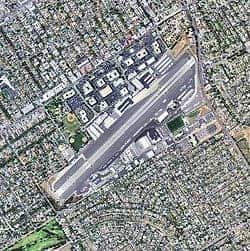UCLA researchers pitted four Los Angeles neighborhoods head-to-head to compare their air pollution levels and found that while more affluent neighborhoods generally fared better, the Mar Vista community near the Santa Monica Airport scored worse for ultrafine particle pollutants than freeway-laced downtown and Boyle Heights and far worse than neighboring portions of West Los Angeles.
Researchers used an emissions-free electric vehicle filled with instruments to measure real-time air pollutant concentrations in residential areas of Boyle Heights, downtown, West Los Angeles and the Mar Vista neighborhood known as North Westdale. During typical daytime weather patterns, the North Westdale community is immediately downwind of the Santa Monica Airport.
Large differences were observed among these communities during summer afternoons that featured very similar meteorology. Noxious particulate concentrations in the North Westdale neighborhood were highest, followed by Boyle Heights and then downtown Los Angeles; neighborhoods in West Los Angeles had the lowest pollutant levels.
The findings are published in December issue of the journal Atmospheric Environment.
Professor Suzanne Paulson of UCLA’s Atmospheric and Oceanic Sciences Department and the UCLA Institute of the Environment and Sustainability headed the study, working with Arthur Winer, professor emeritus at UCLA’s Fielding School of Public Health. The fieldwork was led by Wonsik Choi, a postgraduate researcher in Paulson’s lab.
“The North Westdale neighborhood is heavily impacted by aircraft activities at Santa Monica Airport,” Paulson said. “It has exceptionally high levels of ultrafine particles when aircraft are active, possibly among the highest concentrations of any neighborhood in the Los Angeles area.
“Boyle Heights is particularly impacted by roadway pollution,” she said. “It is nearly surrounded by freeways and crisscrossed by major arterial roads. These streets carry a large number of high-emitting older vehicles, and its neighborhoods are characterized by short blocks with abundant stop signs, causing frequent emission spikes from accelerating of vehicles.”
The UCLA research expanded on previous studies by revealing differences at the neighborhood level instead of regional levels and by focusing on freshly emitted pollutants instead of smog and ozone. Exposure to these pollutants has been linked to increases in asthma, heart attacks, strokes, diabetes, low birth weight, pre-term births and other ailments, the researchers noted.
The researchers found the most striking neighborhood differences in the levels of ultrafine particles, the tiniest airborne particles (less than 0.1 microns in diameter), but the neighborhoods showed many of the same trends with other “tailpipe” pollutants. In contrast, there were not significant differences among neighborhoods in the amount of “traditional” pollutants routinely measured by air agencies, such as fine particulate matter known as “PM2.5” (less than 2.5 microns in diameter).
But tailpipe emissions are not the only source of tiny particles, Paulson noted.
“In Boyle Heights, and to a lesser degree downtown, there are additional ultrafine particles that are not freshly released from vehicles but instead form in sunlight-driven smog processes and are ultimately the result of pollution blown in from upwind areas to the west,” she said.
Air quality is also an environmental justice issue, with poorer neighborhoods more likely to face greater pollution, said Winer.
 “Despite substantial improvements in regional air quality, cleaner air remains a highly desirable amenity in Southern California,” he said.
“Despite substantial improvements in regional air quality, cleaner air remains a highly desirable amenity in Southern California,” he said.
The researchers also uncovered a noticeable drop in ultrafine particle concentrations between 2008 and 2011 in West Los Angeles, which may be attributable to the region’s wealth.
“The decrease in ultrafine particles between 2008 and 2011 in the West Los Angeles area was dramatic,” Choi said. “Affluent West Los Angeles experiences rapid turnover of the vehicle fleet, resulting in a higher proportion of newer vehicles with cleaner engines and better fuel efficiency.”



